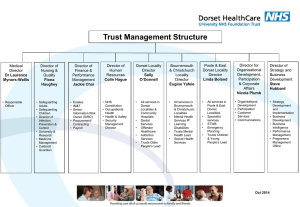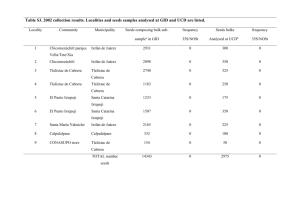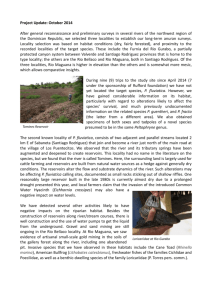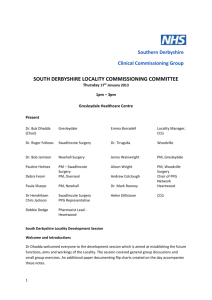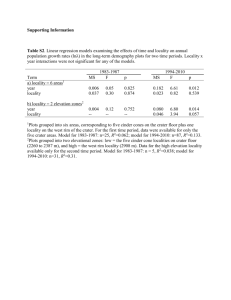1. Notes from Strategic Planning Meeting 14/05/2015
advertisement
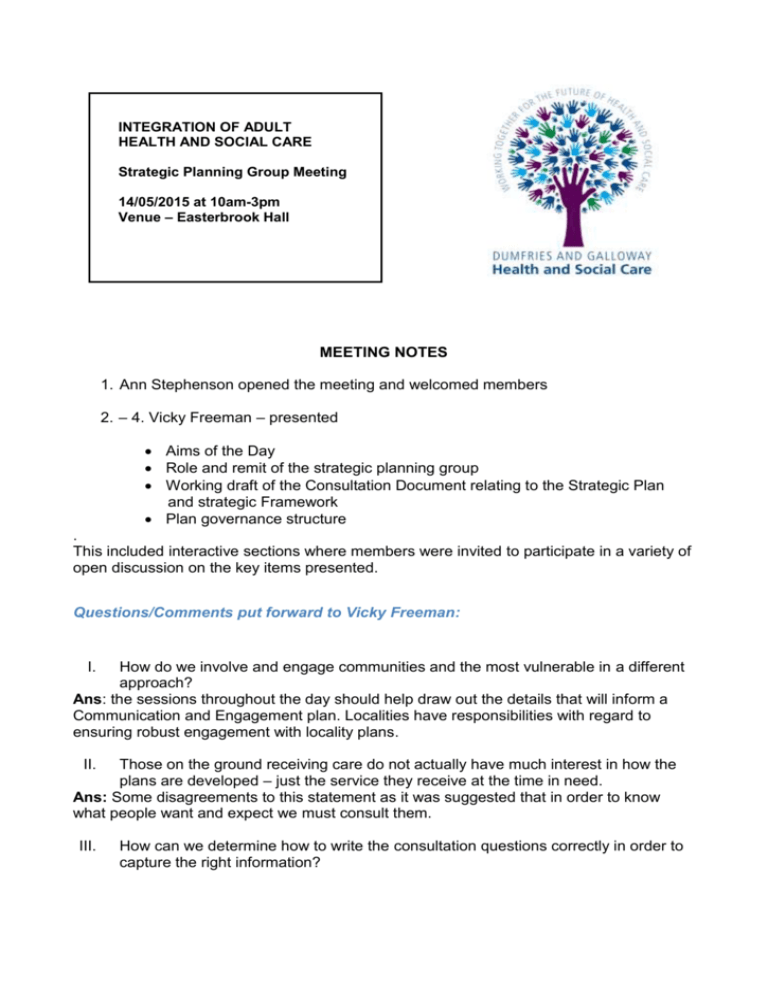
INTEGRATION OF ADULT HEALTH AND SOCIAL CARE Strategic Planning Group Meeting 14/05/2015 at 10am-3pm Venue – Easterbrook Hall MEETING NOTES 1. Ann Stephenson opened the meeting and welcomed members 2. – 4. Vicky Freeman – presented Aims of the Day Role and remit of the strategic planning group Working draft of the Consultation Document relating to the Strategic Plan and strategic Framework Plan governance structure . This included interactive sections where members were invited to participate in a variety of open discussion on the key items presented. Questions/Comments put forward to Vicky Freeman: I. How do we involve and engage communities and the most vulnerable in a different approach? Ans: the sessions throughout the day should help draw out the details that will inform a Communication and Engagement plan. Localities have responsibilities with regard to ensuring robust engagement with locality plans. II. Those on the ground receiving care do not actually have much interest in how the plans are developed – just the service they receive at the time in need. Ans: Some disagreements to this statement as it was suggested that in order to know what people want and expect we must consult them. III. How can we determine how to write the consultation questions correctly in order to capture the right information? Ans: All of us are responsible for bringing these issues together and communicating with the public in an appropriate manner – people understand a great deal more than we sometimes think. Need to be thinking about what services we currently have that help us to meet the 9 national outcomes, and what we might need to change in order to meet these. 6. Julie White discussed integration with the group and the importance of the groups role in shaping and informing the direction that health and social care strategy would take. Q & A with Julie White Q. What is your vision for what services will look like once integrated? A. This will be described in the final strategic plan. Essentially, this will be determined by this group and wider communities. We need to consider how we work with our partners and community in order to work differently. We also need to change the relationships between professionals and people who use services. We should also highlight the fact that an ageing population, whilst does present challenges, is moreover, an asset to D&G. We must recognise the idea of truly shifting the balance of care. It would be difficult to take people out of secondary care and into communities until new ways of working and new models of care are developed and the high demand and pressure on secondary services is released. Q. How can voluntary teams be supported to provide care within the community e.g. training for Ambulance First Responders? A. It is important to look at the totality of all resources available to us rather than just the Integrated Care Fund and how best we use these to support communities Q. Will integration continue to support the culture of tick box exercises and focus on one need and ignore the rest? A. We need to work hard to overcome this and work more collaboratively and share information. There is an IT portal currently being developed by Graham Gault and Graeme McIlorum to try and overcome some of these issues in order for professionals to work in a holistic way. Q. We must be careful not to overload communities – we need to recognise the work of GPs, Nurses, Care providers etc. A. We will listen and work with communities along the way. We recognise the challenge of GP involvement and are considering how we support them. We are also engaging with staff to work together to develop roles. Six additional questions were put on flip charts for Julie. These were put to Julie by email on 22 May 2015. The answers are expected in due course. Additional comments were recorded from the morning on general post-it notes and flip charts and can be found attached to these minutes: 14.05.15 Morning Session Notes Afternoon Interactive Market Place Group 1 - Focused on the Key Challenges section of the plan. Group 2 - Focused on the Vision and purpose of the plan Group 3 - Focused on the Consultation Questions in the plan All comments were recorded from the afternoon sessions can be found attached to these minutes: 14.05.15 Afternoon Session Notes The day was closed at 3:30pm. Dumfries and Galloway Strategic Planning Group (SPG) Thursday 14th May 2015 Flipchart notes – MORNING SESSION General Introductory session General comments on the draft working document What does Assets- based mean? (Jargon) Setting Pointless – Concerned that priorities identified by group are based on evidence What other sources of evidence are (or could be) draw able from this group? Do not overwhelm with paperwork/ reading material, need to ensure information is precise and necessary Communication Key Up and down structures as well as out with structures i.e. communities Clear information in accessible ‘formats’ for all needs Can a group of 45 people draft the plan or just consult on it? Is it practical to ask a group of 45 to write something? For partnership, need people involved to have the right attitude and to value partnerships Document must be circulated well in advance – at least two weeks Ensure Quality signposting is person centred Need to be more thinking and information on what is out there already Want to ensure equality act requirements are observed Mental Health – needs to be an integral part of plan – is there representation from NHS for mental health Clarity around expectations of us as individuals or representative groups Locality plans of Third Sector Involvement and input What is expected of us? I’m listed as a representative of Annandale and Eskdale, I can’t represent everyone in Annandale and Eskdale Why is there not any Mental Health professionals on the group How we create conditions for empowerment/ meaningful risk taking People should not use Jargon or difficult to understand words, when they do they should explain them. Documents need a glossary Questions for Integration – Julie White In practice how different can each locality plan be? Will it work if people living next door have a significantly different service? You mentioned a lot about localities, but how are you going to provide equality of provision strategically so there is No post code lottery What happens when people in the health services (for example) DONT LISTEN? We have been complaining for ages on behalf of folk to do with Mental Health (hospital especially) to get nowhere – we are not heard Will the localities have different level of services? Would people feel they need to move to the locality with the best level of service to them> Are the locality plans already being formulated? Should they be? If so, can we have copies as it is important for this group to have a full picture PARADOX – Culture of scrutiny/ risk adverse – taking meaningful risks Taking into account the views of localities from “Role and Remit of group” Is it enough to just take it into account? Stuffed by governance Need to have strategic – Agreements that overarch local plans so preventing postcode lottery of provision and access to Integration and levels of expectation Structures Visual of how the localities work- e.g. what feeds in where? – Who to contact. Hopefully all localities will have similar structures for us to work with Need balance of localities PLUS sector make sure acute doesn’t dominate Service delivery in localities need to feed in to regional services – how will this be addressed Link to community councils Link to Third Sector First Thematic Groups May require additional representation from localities to ensure diverse coverage Listen to Yourself and others What matters to the public? Whose needs will be met by this? Need to find new ways of working together – partnership collaboration outcomes Define Services being offered Imbed quality measurements Basis of measurement of customer satisfaction Articulate locality priorities mapped against key strategic challenges Mechanism in locality to engage with locality - How do we reach the “Hard to Reach” Some merit in dovetail consultation on strategic and locality plans. We probably all want to get the same feedback but at different levels of detail Fear of the older carer of how to access appropriate services Must get agenda for meeting and it should be mostly what the meeting will be about. Should not be big changes made at the meeting Electing a chair For a chair we need a person who can make necessary commitment and deliver the brief required so they will Have to put themselves forward Tell us about themselves We need to be able to question them Personal Qualities Gravitas Discernment Self awareness 1. Clarity of commitment required- time etc 2. Members asked to submit expression of interest including deciding about what they should bring to the role and their understanding of Strategic Planning Group 3. Submissions circulated to group members and a vote organised 4. Need to do similar for Vice Chair Specification for the role Personal Specification – “formal” recruitment/ application process and Task & Finish group to take this forward Inviting people who are interested to write a bit about themselves so people can see the skill set Find out who would be interested Per patient experiences and what they would bring Ballot Depute Length and time of office depute Independent Chair? What would the roles and responsibilities of group community and nominations Joint Strategic Planning Group – Rules of Engagement Formation of short term. Task and finish groups for thematic work On Line discussion forums – topic/threads To continue/hone the dialogue We should make a much bigger effort to make information more understandable to more people Need to look at Structure and culture – need to each respect culture and understanding of everyone else Recognising that each of us and each group we represent has very different needs and expectations Respect for each other – values and contributions Potentially more time to “build the team” and get to know each other Sharing of personal profiles? Listening to each other Respecting each other Recognising that each person’s position is as valid as your own Should work in ways that encourage us to think “out of the box” All views and suggestions must be valued and considered Virtual Meetings Encourage and make it possible for us to send ideas, proposals, questions etc into a central person in between our meetings and that information is to be passed onto other members Defining the services today Sub groups that are representative of its group to assist the process – feed in to contact coordinating group Central co-ordinating contact for the group to feed into We need to trust the sub groups to represent the full views of the people we represent Trust, Respect, Relationships Human Resources Representation on SPG required Behaviours reflect the way we want the localities etc to behave Whilst we may find change difficult and worrying, it will have to happen and we should remember it does happen all the time and it can be successful Dumfries and Galloway Strategic Planning Group (SPG) Thursday 14th May 2015 Flipchart notes – AFTERNOON SESSION Group 1 looked at section 4 - Key Challenges Group 1 - Session 1 Q1 Comments on Plan The Plan is tackling a large and varied subject and is a great starting point that can be built on Human scenarios would be helpful in starting to think through how we need to change service delivery Group 1 - Session 2 Perhaps too much looking back and not as much ‘how’ going forward Focus on peoples mental / emotional health Present and anticipated demand on community based support/supported housing options Group 1 – Session 3 The use of language throughout is professional but needs to be plain English Strategic Plan – is in language of the ‘powerful’ Group 1 - Session 1 Keeping people safe Does technology have a bigger role to play in delivering care Workforce development Our existing and supporting workforce through the change and maximising the resource we have Identification of need and assessment of individual not being constantly repeated Increasing number of carers and encouraging identification through all sources To develop real and meaningful partnerships within integration in order to achieve better outcomes for people Use case examples to illustrate how it could be Train for reablement Third sector vital to moving forward Culture Challenges How can we change the perceptions of what can be done Needs to be defined. Key challenge Q1 Comments on Plan Q1 Comments on Plan Underpinning principle of integration, empowerment/enablement Where is the core inspectorate in all this Q2 Key Challenges Variability Prescriptions Referrals What are the limits of our ability to deliver care Need for all to own partnership - if not then integration will not be meaningful to the individual Make caring valued How to share the burden – t/f skills Learning disability and reaching hard to reach Put the person at the centre of care outlined around carers Challenge of transparency of resource Group 1 - Session 2 Balancing day job with transformation is a challenge and capacity within the system to involve staff to move this forward Consistent message across Partners to manage expectation Early intervention, break the cycle of hospital admissions People who are medically fit do not need to be in hospital Prevention and early intervention for people requiring services and not being hospitalised Resourcing; transitional arrangements for services £ and skills Taking the community with us, encouraging the community at large to accept and embrace the change Moving services – people changing jobs, changing culture. How do we change to using that unique skill that different professions can offer and using others to do other parts of their jobs ‘SEED’ monies to develop new approaches and services. Move resources from traditional services to new services How do we attract people into jobs in the first place Agreeing an integrated workforce plan with all partners: Third sector, voluntary and independent sector Group 1 Session 3 Future sustainability of GP/primary care services including out of hours Need to tackle health and care inequalities /poverty Q2 Key Challenges Challenges should address avoiding unnecessary admission and facilitate effective discharge and enablement pathways to home/own community Challenge – cultural shift of population to be responsible for own health and wellbeing Improve flow for user (not system) to meet their support requirements Exercise is important for health both physical and mental and to counteract obesity. But when you are prevented from moving due to injury, there is no help Shifting resources (widest sense) to community Shifting people’s expectations - with rights go responsibilities Getting people to think in a different way so we can come up with significant different approaches Optimise the use of assets and resources (including people) to support the needs of the community Lack of appropriate housing to meet projected demand for housing, and areas where people wish to live / creating sustainable and balanced communities Sustainability of care providers in the region: Fees Staffing, recruitment etc Career posts Being valued Nursing homes should be able to back up hospitals with staff who are better trained and with a career structure Key Challenges Present and anticipated demand on care at home services Reducing working age population Recruitment of health and social care professionals + care +mental health, third and statutory sector Rise in hospital admissions and delayed discharges Real partnerships need to be developed (not at present) for true integration which benefits all Equality of provision. Local plan –vstrategic - possible postcode lottery Group 1 Session 3 continued People coping with multiple conditions (including ageing) will include carers of people with other conditions Staff should not be protecting their own patch to the exclusion of those regarded as not qualified – but better placed to bring about the right outcome Key challenge – getting all to ‘buy in’ to mental health services Challenge of paradox – risk aware culture – scrutiny vs. taking meaningful risks – doing things differently How do we attract people into the workplace and then how do we keep them Increasing number of people with multiple long term conditions, including dementia Lack of appropriate housing to meet projected need Various partners to ‘buy in’ and commit to new ways of working e.g. not protective of status quo. Co-production and getting commissioning right Input and involvement in locality plans for third sector organisation which delivers across the region Key challenge, dealing with all organisation’s egos Key Challenges Challenge – educating us all that we should not expect to be able to get everything that is possible, irrespective of cost and resources How we work together: What we have in common Build relationships of trust Making sure we go back to values to help integration Sustaining people safely and independently at home. Responding quickly in a timely manner Transport Looking at the ‘Whole Person’ in practice, holistic approaches and integrated working across practitioners. Staff need to look beyond the immediate presenting problem which could include Physical and mental health and wellbeing issues. There needs to be referrals to other professionals and organisations and those that need assistance signposted to the right services and support needed. Cutting out duplication with information sharing so that the person does not have to provide the same information repeatedly. Changing culture in paid staff: staff are not currently practicing in an integrated way. The key challenge is to shift the staff cultures and needs to be part of the performance management and supervision agenda with services. Staff should have to demonstrate knowledge and understanding of the Health and Social Care integration and actual action in their practice that demonstrates and reflects a Health and Social Care Integration. Group 2 looked at section 5 - How we plan to achieve our Vision and Purpose Group 2 – 1st Session Deal with perceptions - explaining Technology and computers (necessity) Enabling communities to overcome fear of computers/technology Don’t use technology for its own sake – use it for a practical purpose Include examples as part of consultation Housing plans need to move forward based on current and projected needs. Localities know what they need Transport is a key issue country wide for health inequalities Postcode lottery Knowledge/Information signposting to support/ services available in locality and beyond How can people have more choice when they are in a mental health hospital and their choices are taken away – i.e. visiting hours are awful and no bedside visiting Be careful of “postcode lottery” of services. Need to be tied in with strategic plan Building Safe Communities Carer’s legislation will allow change from assessment to support plan. While this may be for those in critical need – the third sector will be able to assist with less formal plans that may not impact on services Choice and Control Need to know what is available before these options - This may differ in localities and we need to ensure consistency and access Need to move from silos of professional working Focus on user and carer priorities not professionals Developing Communities/ Community Resilience - Need to make sure Strategic Outcomes are embedded in local plans Optimising Efficiency – Develop a model for commissioning. Open / Transparent CoProduction partners letting go of services – disinvestment (re-evaluating) Integrated Workforce Plan – Development – Across all partners Public/ Private, Third Are we doing the right things to achieve the Vision and Purpose and address the key challenges? There was some discussion around ensuring the use of language is appropriate e.g. what do we mean when we say optimising the use of technology – this is more than using computers and suggest using examples to illustrate what we mean (door sensors etc.) Do the suggested approaches cover the needs of everyone who lives in D&G? What do we mean by communities? This could be defined by geography, common interests, conditions etc. We need to be careful with the language we are using. Is there anything missing? It was suggested that Prevention and Anticipatory Approaches are two different things and these should be split. Group 2 – Session 2 Locality Plans will be the area where we can cover the needs everyone in Dumfries and Galloway. Locality however need not replicate each other Invest in the support for getting the locality plan sorted Bias against change – be clear about care for change Strategic Plan should be brief enough not to need an exec summary Group 2 – Session 3 Need to explain Investment and disinvestment Integrated workforce plan Preventive and Anticipatory Making use of technology Workforce Intelligence Choices include life choices as well as what service you use, when to use it, which GP you use etc. Older people need support and education on which services to access i.e. a champion Revisit Dumfries and Galloway Carers Strategy in light of NHS/S/Work Transition Expand the work of nursing home to be able to care for more complex medical problems. Staff would need better recognition, a career structure and better pay Technology Needs to include all technology including equipment, Telecare and electronics Role of adaptations and re-design of home environments Technology Access to web connection speed enabling technology Keeping people safe How to keep people fit and healthy and link with wider services e.g. sport and leisure More effective use of workforce skills Single point of contact for people and efficient signposting Preventative Anticipatory Approaches - Separate in to two 1. Prevention and well being 2. Anticipatory Approaches Overall themes: Could be reflected in Strategic plans and locality plans Prevention Early intervention Capacity Building Care and Support Workforce Development – to support the above Resources – savings are not the driver but if we get service right we will create savings etc. E.g. early intervention initiatives ‘Shifting the focus from institutional care to home and community based services’ This to be changed to: Shifting the focus from institutional care to care and support in the community’ Use frontline staff and practitioner links on the ground to link with people who use services. Use contacts at a locality level to make links with people who use services to encourage people to get involved take comments/feedback on consultation documents. Suggestion to develop a single A4 flyer with 3 key messages on Health and Social Care integration and points of contract for verbal discussion/verbal feedback. Flyer to be given out at the point of contact with services. Group 3 looked at section 8 – Consultation Questions GROUP 3 – 1st Session Explain in simple terms input including reasons for questionnaires Structure questions to be more captive to reader How will locality questions lead to strategic plan questions Timing Query wording of draft priorities Q1 and Q2 are the same thing What will the forms of communication be: Paper, web based, survey monkey, use ‘browse aloud’ Closed questions not popular Engage with: SCLD SAIF Timescales for actions Should use the groups and organisations that exist and they can “personalise” the questions and approach to their group To engage with many of the community the wording of draft priorities will need to be explained or made easier to understand Structured interviews and severely Affected service users as well as gaining this input it also informs the Strategic Planning group and is an interactive process In Questionnaire, instead of telling people that these are “the draft priorities” Ask “do you think these are good priorities or some such wording Group 3 – Session 2 The consultation questions first of all presume that the people answering can read and understand the strategic plan Need to ask “Do you understand what this strategic plan means?” Expert Facilitation skills required Know your audience Accessibility – both physical and intellectual methods e.g. Non Instructed Advocacy, Easy read verbal Make sure people are interested by this and the facilitation right otherwise people will think they are being preached at or not engaged What would you like health and social care to look like in the future? Or What matters to you? Is the consultation plan to include groups that clearly reach hard to reach groups Engagement of Consultation Plan – needs to be far reaching, creative and ensure available and supported consultation at local group and individual level Short term consultation plans Ongoing local consultation/ engagement using local ‘champions’ to feed into interactive evolving strategic plan Process helps to build community Have Community councils been involved? Have missed out people’s rights – if people don’t know what their rights are, how can we ask them if this meets those rights? Think there needs to be public presentations using friendly language, followed by these two questions to replace question 1: What healthcare needs and social care needs do you have? Does this plan meet your needs? Assets mapping, what’s important to you as individuals/ communities? What activities do you enjoy together as a community? Inform Strategic Plan - what strategic decisions/planning priorities such as community well being In taking out to localities - raise asset mapping, the positives – services which are achieving and not just negative. Then what they need Group 3 – Session 3 Most Important Issues Its missing: Keeping People Safe Need spec of what final plan will look like – Strategic Planning Workstream Very Challenging for Strategic Planning Group to develop plan when not promoted with evidence of needs Training for group in strategic planning Use best practice / research to ‘hone’ feedback questions Just ask 1 question – what do you think about our plan? Reviewing of the strategic plan on a yearly basis Does what you’ve read make you think your treatment and care would be better? If not, what else would you like to see included? Consultation with Public Use of social media – Facebook (Locality agenda) How could things be improved by you? Include use of social media in consultation Use existing tools for community engagement Use to existing workforce to support community engagement process Need more regular reviews of street plan (not three years) Things change – suggest they should be done annually Idea ok, the opportunity for discussion out-with the main group is helpful Vision and Purpose’ Session - It was hard in this group to know what was being asked for the discussion groups (and further consultation). You need really simple and clear questions for people to answer and these were not simple and clear.


